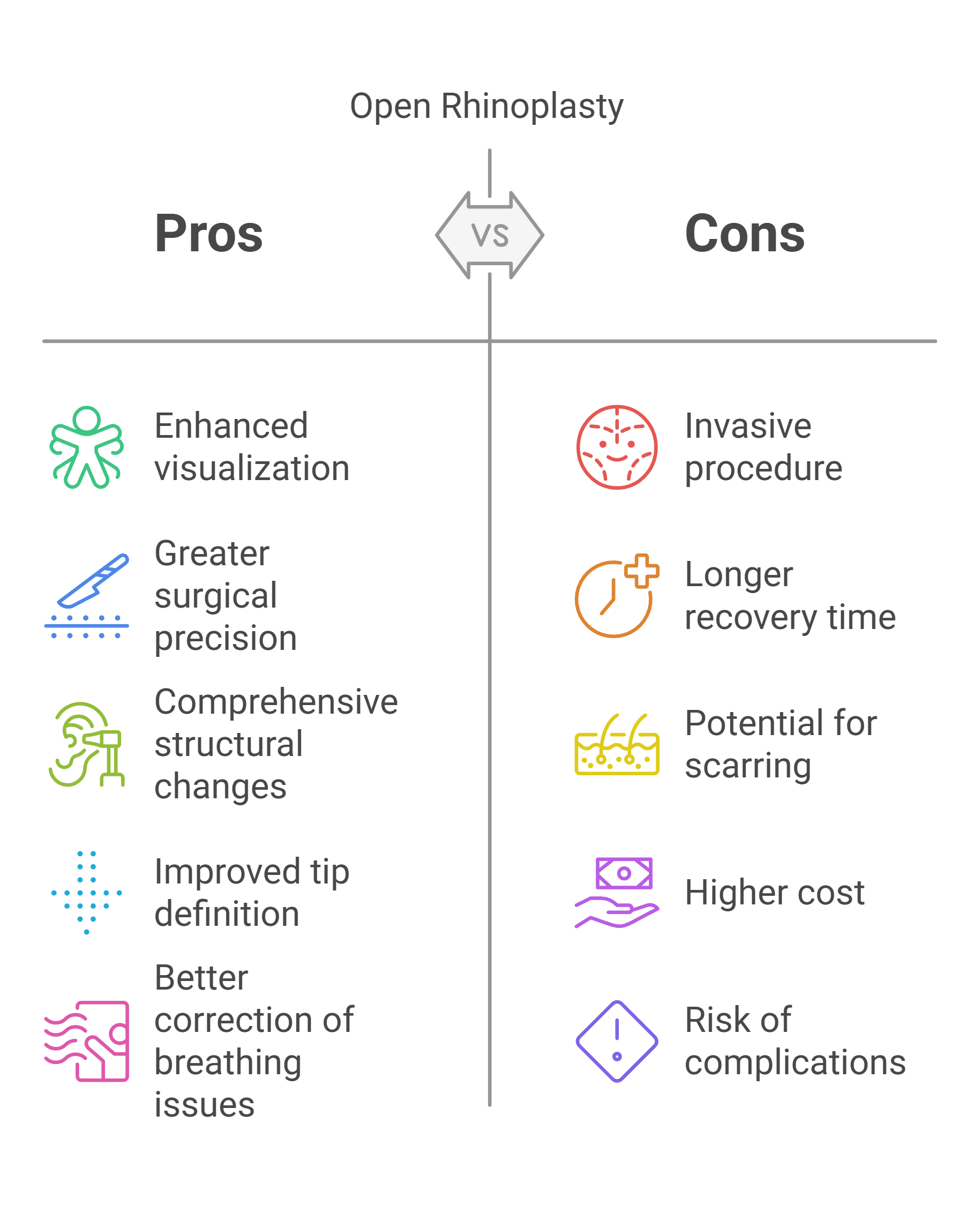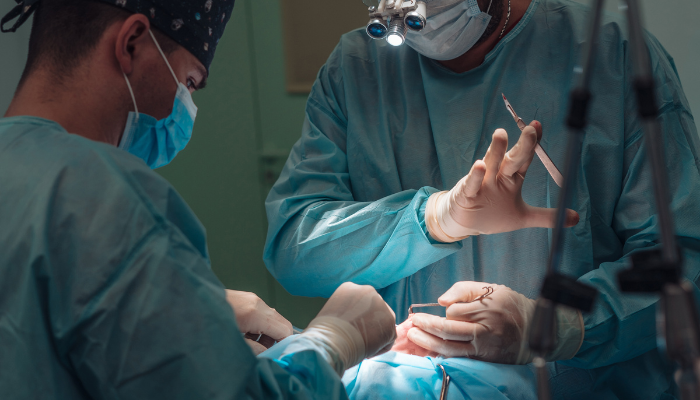Open rhinoplasty is a surgical procedure aimed at reshaping the nose for aesthetic or functional reasons. Unlike closed rhinoplasty, where all incisions are made inside the nostrils, open rhinoplasty involves a small incision on the columella, the skin between the nostrils.
This technique allows surgeons to have better visibility and access to the nasal structures, making it a preferred choice for more complex cases. In this article, we’ll break down the details of open rhinoplasty, including the procedure, benefits, risks, and recovery process.
Key Takeaways
- Open rhinoplasty involves an external incision for better visibility.
- It’s suitable for patients needing significant changes or corrections.
- Recovery can take longer compared to closed rhinoplasty.
- Potential risks include scarring and complications such as infection.
- Choosing a skilled surgeon is essential for optimal results.
Understanding Open Rhinoplasty

Definition and Overview
In simple terms, it’s a type of nose surgery where the surgeon makes a small incision on the columella – that’s the bit of skin between your nostrils. This allows them to lift the skin and have a really good look at the underlying structures of your nose.
Key Differences from Closed Rhinoplasty
The main difference between open and closed rhinoplasty boils down to access.
- With closed rhinoplasty, all the incisions are made inside the nostrils. This means less visible scarring, which sounds great, right? But it also means the surgeon has a more limited view.
- Open rhinoplasty, on the other hand, gives the surgeon a much clearer view and more room to work. Here’s a quick comparison:
| Feature | Open Rhinoplasty | Closed Rhinoplasty |
|---|---|---|
| Incision | Small incision on the columella | Incisions inside the nostrils |
| Visibility | Excellent | Limited |
| Scarring | Minimal, usually well-hidden | No visible external scarring |
| Complexity | Suitable for complex and minor corrections | Best for minor corrections |
| Recovery | Slightly longer | Slightly shorter |
Ideal Candidates for Open Rhinoplasty
So, who is open rhinoplasty actually for? Generally, it’s a good option for people who need more significant changes to their nose. This could include:
- Correcting a severely deviated septum.
- Reconstructing the nose after an injury.
- Addressing complex aesthetic issues, like a very crooked nose.
- Revision rhinoplasty (fixing problems from a previous nose job).
It’s important to remember that everyone is different, and what’s right for one person might not be right for another. The best way to find out if open rhinoplasty is suitable for you is to have a chat with a qualified and experienced surgeon. They’ll be able to assess your individual needs and goals and recommend the best course of action.
The Open Rhinoplasty Procedure
Step-by-Step Surgical Process
Let’s break down what actually happens during the procedure.
- First off, you’ll be given a general anaesthetic, so you won’t feel a thing. The surgeon makes a small cut on the columella – that’s the bit of skin between your nostrils. This is the key difference between open and closed rhinoplasty.
- Then, the surgeon gently lifts the skin to see the bone and cartilage underneath.
- They can then reshape the nose by removing or adding bone or cartilage.
- Sometimes, they might use grafts from another part of your body to get the look you want.
- Once they’re happy with the new shape, the skin is put back in place and the cut is closed with stitches. It’s all about careful adjustments to get the best result.
Anaesthesia and Recovery
As I mentioned, open rhinoplasty is usually done under general anaesthetic, which means you’ll be completely asleep during the operation. This is to make sure you’re comfortable and don’t feel any pain. The surgery itself can take anywhere from two to four hours, depending on how much work needs to be done.
After the surgery, you’ll wake up in the recovery room. You might feel a bit groggy, but the nurses will keep a close eye on you. Most people stay in the hospital for a night to make sure everything is okay before heading home. It’s a good idea to have someone pick you up and stay with you for the first day or two, just in case.
Post-Operative Care and Considerations
So, you’re back home – now what? Post-operative care is really important for a smooth recovery. You’ll probably have a splint and some packing inside your nose to support it while it heals. Here’s a few things to keep in mind:
- Keep your head elevated, even when you’re sleeping. This helps to reduce swelling.
- Take any pain medication as prescribed by your surgeon.
- Avoid strenuous activities for several weeks.
- Be gentle when cleaning around your nose.
It’s normal to experience some bruising and swelling after the surgery. This will gradually get better over the next few weeks. Make sure you attend all your follow-up appointments with the surgeon so they can check how you’re healing. If you have any concerns, don’t hesitate to give them a call. They’re there to help you through the whole process.
Benefits of Open Rhinoplasty

Open rhinoplasty, while involving a slightly more involved procedure, offers several distinct advantages that can lead to superior outcomes, especially in complex cases. Let’s explore some of the key benefits.
Enhanced Visibility for Surgeons
One of the primary benefits of open rhinoplasty is the unparalleled visibility it provides to the surgeon. By making a small incision on the columella (the strip of skin between the nostrils) and lifting the skin, the surgeon gains direct access to the underlying nasal structures.
This allows for a clear and unobstructed view of the bone and cartilage, making it easier to perform precise and intricate modifications.
Greater Control Over Surgical Outcomes
With enhanced visibility comes greater control. Open rhinoplasty allows the surgeon to have a more hands-on approach to reshaping the nose. This is particularly beneficial when dealing with issues such as:
- Correcting a severely deviated septum.
- Reconstructing a collapsed nasal valve.
- Performing complex tip refinements.
The increased control afforded by open rhinoplasty translates to a higher degree of accuracy and predictability in achieving the desired aesthetic and functional results. It’s about having the ability to fine-tune every detail.
Flexibility in Addressing Complex Issues
Open rhinoplasty offers greater flexibility in addressing a wide range of nasal issues, from minor cosmetic tweaks to major structural corrections. This technique is particularly well-suited for patients who have:
- Undergone previous nasal surgeries.
- Significant nasal asymmetry.
- Complex breathing problems.
Because the surgeon has direct access to the nasal framework, they can employ a variety of advanced techniques, such as cartilage grafting and suture reshaping, to achieve optimal results. It’s like having a full toolbox at your disposal, ready to tackle any challenge.
Potential Risks and Complications
Like any surgical procedure, open rhinoplasty comes with potential risks and complications. It’s important to be aware of these, but also to remember that serious complications are rare, and your surgeon will take every precaution to minimise them.
Common Risks Associated with Surgery
So, what are the common things to watch out for?
- Infection is always a possibility, though it’s not super common.
- Bleeding is another one – you might get some bruising and swelling, which is pretty normal.
- Some people experience altered sense of smell, while others find that their nasal breathing is affected.
- Minor bleeding is common while heavy bleeding is very rare but can be severe.
- And then there’s the anaesthesia itself, which carries its own small set of risks, but the anaesthetist will go through all that with you beforehand.
Managing Complications Effectively
Okay, so what happens if something does go wrong? The key is early detection and quick action. Your surgeon will give you a list of things to watch out for, and it’s really important to follow their instructions carefully.
If you notice anything unusual – like excessive bleeding, signs of infection, or a sudden increase in pain – get in touch with your qualified surgeon right away. Most complications can be managed effectively with prompt treatment, like antibiotics for an infection or a revision surgery to correct structural issues.
Importance of Choosing a Qualified Surgeon
Honestly, the single most important thing you can do to minimise risks is to choose a surgeon who’s properly qualified and experienced. Look for someone who’s a member of a recognised professional body, and don’t be afraid to ask about their training and experience.
A good surgeon will be happy to answer your questions and put your mind at ease. They should also be able to show you before-and-after photos of their previous patients, so you can get an idea of their skill and aesthetic sense.
Recovery After Open Rhinoplasty
Typical Recovery Timeline
Now comes the bit everyone wants to know about: the recovery. Let’s break down what you can expect, because honestly, it’s not a sprint, it’s more of a marathon.
- First 1-2 Weeks: Expect swelling and bruising. It’s usually at its peak around day 3, then starts to gradually fade. You’ll probably have a splint and maybe some stitches. Take it easy, rest up, and follow your surgeon’s instructions to the letter.
- 2-4 Weeks: The splint comes off, and you’ll start to see some of the changes, but remember, there’s still swelling. Avoid strenuous activities.
- Months 2-6: The swelling continues to subside. Subtle refinements are happening. You’ll start feeling more like yourself.
- Up to a Year: The final results become apparent. It takes time for everything to settle into its new position.
Honestly, the waiting game is the hardest part. Just remember that good things come to those who wait (and follow their surgeon’s advice!).
Tips for a Smooth Recovery
Okay, so you know what to expect, but how do you make the whole process a bit easier? Here are a few tips I’ve picked up along the way:
- Keep your head elevated: Especially when sleeping. This helps reduce swelling.
- Use cold compresses: They’re your best friend for the first few days.
- Avoid strenuous activity: No gym, no heavy lifting, nothing that gets your heart racing.
- Eat a healthy diet: Good nutrition helps your body heal.
- Stay hydrated: Water is key for everything, including recovery.
- Follow medication instructions: Pain relief and antibiotics are there for a reason.
- Attend all follow-up appointments: Your surgeon needs to check on your progress.
Signs of Complications to Watch For
While most open rhinoplasty recoveries go smoothly, it’s important to know what to look out for. If you experience any of the following, contact your surgeon immediately.
- Excessive bleeding that doesn’t stop with gentle pressure.
- Signs of infection, such as increased redness, warmth, or pus.
- A sudden increase in pain or swelling.
- Difficulty breathing.
- Fever.
It’s always better to be safe than sorry. Don’t hesitate to reach out to your surgical team if you have any concerns. They’re there to help you through this process and make sure you get the best possible outcome.
Comparing Open and Closed Rhinoplasty

When to Choose Open Rhinoplasty
So, you’re weighing up your options for a nose job? It’s a big decision, and understanding the difference between open and closed rhinoplasty is key. Open rhinoplasty is often the go-to when significant reshaping is needed.
Think complex cases like major asymmetry correction, or when dealing with substantial cartilage or bone work. The external incision allows the surgeon a much clearer view and greater access to the underlying structures. Basically, if it’s a tricky job, open rhinoplasty is usually the better bet.
Advantages of Closed Rhinoplasty
Closed rhinoplasty, on the other hand, is all about minimal intervention. The big plus? No external scars! Everything’s done through the nostrils. This usually means less swelling and a quicker recovery.
It’s often preferred for minor tweaks, like smoothing out a small bump or refining the tip a little. Plus, the surgery time is generally shorter. It’s less invasive, which is always a bonus, right?
Making an Informed Decision
Choosing between open and closed rhinoplasty really boils down to your individual needs and what you’re hoping to achieve. It’s not a one-size-fits-all situation. Here’s a few things to consider:
- The extent of the changes you want.
- Your surgeon’s experience with each technique.
- Your tolerance for downtime.
Ultimately, the best approach is to have a good chat with your surgeon. They can assess your nose, listen to your goals, and recommend the most suitable technique for you. Don’t be afraid to ask questions and get all the info you need to feel confident in your choice. It’s your nose, after all!
Long-Term Results of Open Rhinoplasty
Expected Longevity of Results
Well, the good news is that the results of open rhinoplasty are generally considered permanent. That’s a pretty big deal, right? Once the structural changes to your nose have fully healed, they should last a lifetime.
However, it’s important to have realistic expectations. While the surgery itself provides lasting changes, the natural ageing process will still affect your nose over time, just like any other part of your body. Think of it as setting a new baseline, rather than stopping time altogether.
Factors Influencing Outcomes
Loads of things can affect how your nose looks years down the line. Here’s a quick rundown:
- Surgical Technique: Obviously, a skilled surgeon using the best techniques will give you a better chance of long-lasting results.
- Healing Process: Everyone heals differently. Some people might experience more scar tissue formation, which can subtly alter the appearance of the nose.
- Lifestyle: Big changes in weight can affect the skin around your nose. Also, repeated trauma (like from sports) could potentially impact the structure.
- Ageing: As we get older, the skin loses elasticity, and cartilage can weaken. This can cause the nose to droop slightly or change shape over many years.
Maintaining Your New Look
Okay, so you can’t stop time, but you can take steps to protect your investment. Here are a few tips:
- Sun Protection: Protect your skin from sun damage, as this can affect skin elasticity.
- Healthy Lifestyle: Maintaining a stable weight and avoiding smoking can help preserve skin quality.
- Avoid Trauma: Be mindful of activities that could cause injury to your nose.
- Follow-Up Appointments: Keep up with any recommended follow-up appointments with your surgeon. They can monitor any changes and offer advice.
It’s worth remembering that even with the best care, some subtle changes are inevitable as you age. However, by following these tips and working with a skilled surgeon, you can maximise the longevity of your rhinoplasty results and enjoy your new look for many years to come.
Conclusion
Open rhinoplasty is a surgical option that offers a clear view of the nasal structures, allowing for precise adjustments. While it may involve a longer recovery and some visible scarring, the benefits often outweigh these concerns for many patients.
If you’re considering this procedure, it’s essential to consult with a qualified surgeon who can guide you through the process and help you achieve your desired results. Remember, the journey to a new nose is not just about aesthetics; it’s about enhancing your confidence and improving your quality of life.
Frequently Asked Questions
What is open rhinoplasty?
Open rhinoplasty is a type of nose surgery where the surgeon makes a small cut on the outside of the nose, between the nostrils. This allows them to see the inside of the nose better and make more detailed changes.
How is open rhinoplasty different from closed rhinoplasty?
In closed rhinoplasty, all cuts are made inside the nostrils, so there are no visible scars. Open rhinoplasty gives the surgeon a better view but leaves a small scar on the outside.
Who is a good candidate for open rhinoplasty?
People who want to make significant changes to their nose or have complex issues, like a deviated septum, are often good candidates for open rhinoplasty.
What happens during the open rhinoplasty procedure?
The procedure usually takes a few hours. The surgeon makes an incision, lifts the skin, and reshapes the nose by removing or adding bone or cartilage as needed.
What are the benefits of open rhinoplasty?
The main benefits include better visibility for the surgeon, more precise control over the changes, and the ability to address complex nasal issues.
What should I expect during recovery from open rhinoplasty?
Recovery can take a few weeks. You might have swelling and bruising, and it’s important to rest and avoid strenuous activities during this time.





